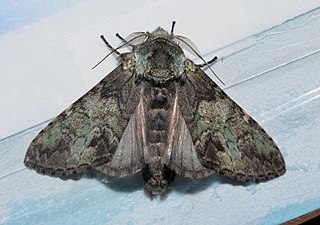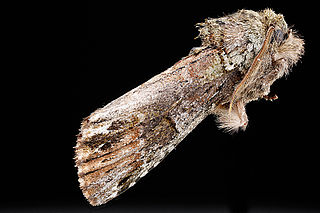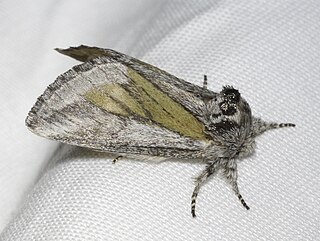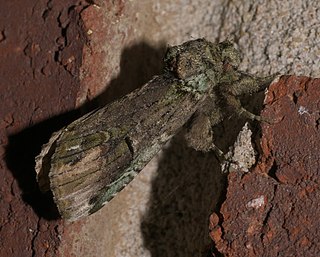
Notodontidae is a family of moths with approximately 3,800 known species. The family was described by James Francis Stephens in 1829. Moths of this family are found in all parts of the world, but they are most concentrated in tropical areas, especially in the New World.

Americerura scitiscripta, the black-etched prominent, is a moth of the family Notodontidae. It is found from Quebec west to eastern Alberta, south to Florida and Texas. The species was formerly placed the genus Tecmessa, and the genus Cerura, which is now restricted to the Old World.

Stauropus alternus, the lobster caterpillar, lobster moth or crab caterpillar, is a moth of the family Notodontidae. It is found in the north-eastern Himalaya, Sri Lanka, Sundaland, the Philippines, Sulawesi and the southern Moluccas. It was described by Francis Walker in 1855.

Caribojosia is a monotypic moth genus in the family Notodontidae. Its only species, Caribojosia youngi, is found in the Dominican Republic and adjacent Haiti. Both the genus and species were first described by John E. Rawlins and James S. Miller in 2008.
Eremonidia is a monotypic moth genus of the family Notodontidae. Its only species, Eremonidia mirifica, is known from two mountain ranges in the south-western part of the Dominican Republic. Both the genus and species were first described by John E. Rawlins and James S. Miller in 2008.

Macrurocampa is a genus of moths of the family Notodontidae erected by Harrison Gray Dyar Jr. in 1893. They are found primarily in North America.

Heterocampa is a genus of prominent moths in the family Notodontidae. There are about 18 described species in Heterocampa, found in North, Central, and South America.

Disphragis is a genus of moths of the family Notodontidae erected by Jacob Hübner in 1820. The genus is confined to the New World and it contains about 137 species.

Schizura is a genus of prominent moths in the family Notodontidae. There are about eight described species in Schizura.

Coelodasys unicornis, the unicorn caterpillar moth, unicorn prominent or variegated prominent, is a species of moth in the family Notodontidae. It was first described by James Edward Smith in 1797 and is found in North America south of the Arctic.

Somera is a genus of moths of the family Notodontidae. The genus was erected by Francis Walker in 1855.

Dunama is a genus of moths of the family Notodontidae described by William Schaus in 1912.
Dicentria is a genus of moths of the family Notodontidae. The genus contains about 46 described species occurring from Mexico south to Bolivia and Paraguay. Its affinities to the North American genera Schizura and Oligocentria are not fully understood.

Astiptodonta wymola is a species of prominent moth in the family Notodontidae. It was first described by William Barnes in 1905 and it is found in North America.
Astiptodonta aonides is a species of prominent moth in the family Notodontidae. It was first described by Strecker in 1899 and is found in North America.

Tecmessa is a Neotropical genus of moths of the family Notodontidae described by Hermann Burmeister in 1878, and historically confused with the Old World genus Cerura.

Cecrita is a genus of prominent moths in the family Notodontidae. There are about eight described species in Cecrita, found in North, Central, and South America.

Coelodasys is a genus of prominent moths in the family Notodontidae. There are at least four described species in Coelodasys, found in North America.

Oedemasia is a genus of prominent moths in the family Notodontidae. There are at least four described species in Oedemasia, found mainly in North America.
















